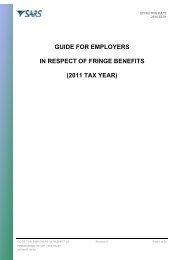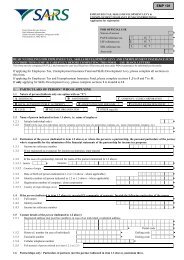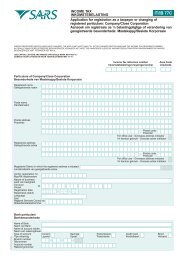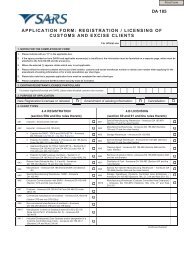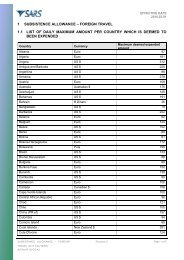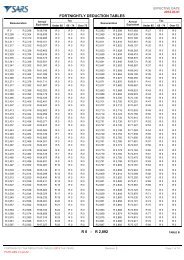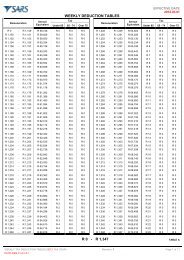EMP201 Guide - Moneywebtax
EMP201 Guide - Moneywebtax
EMP201 Guide - Moneywebtax
You also want an ePaper? Increase the reach of your titles
YUMPU automatically turns print PDFs into web optimized ePapers that Google loves.
• The new <strong>EMP201</strong> solution allows SARS to introduce a clearing account for<br />
employers.<br />
• This will enable SARS to provide the employer with a consolidated view of all<br />
employer taxes. On receipt payments will be stored in the employer’s clearing<br />
account. The <strong>EMP201</strong> will then specify the automatic allocation of the payment<br />
from the clearing account to PAYE, SDL and UIF.<br />
• Any under- or over-payment is easily identified, and the employer automatically<br />
notified. This will provide employers with the capability to correct an allocation or<br />
process a missing allocation. It also encourages employers to be more accountable<br />
for the accuracy of their accounts, thereby removing bottlenecks in the correction<br />
process.<br />
• The three different banking accounts for PAYE, SDL and UIF will be consolidated<br />
into the PAYE account (Beneficiary ID: SARS - PAYE).<br />
• This will result in a far more efficient payment process for both SARS and the<br />
Taxpayer requiring one payment to be made.<br />
2. UNDERSTANDING THE NEW <strong>EMP201</strong> DECLARATION<br />
PROCESS<br />
Employers will no longer be required to complete both a payment liability and a payment<br />
declaration on an <strong>EMP201</strong> form. The new <strong>EMP201</strong> form to be introduced will be an<br />
employer payment declaration that requires employers to indicate the total payment made<br />
and give a breakdown of PAYE, SDL and UIF payment allocations.<br />
These payment allocation amounts will then be recorded as the employer’s provisional<br />
liability for each tax type for the period concerned. Your EMP501 reconciliation at the end<br />
of the financial tax year will provide the actual liability.<br />
This means that employers will only make one payment as opposed to three separate payments<br />
for PAYE, SDL and UIF. The <strong>EMP201</strong> form will therefore be used for a single period to declare<br />
how that payment must be allocated for each tax type.<br />
The Payment Reference Number, a new field on the <strong>EMP201</strong> form, links the actual payment<br />
and the relevant <strong>EMP201</strong> payment declaration.<br />
PAYE <strong>EMP201</strong> - A GUIDE FOR EMPLOYERS 3



